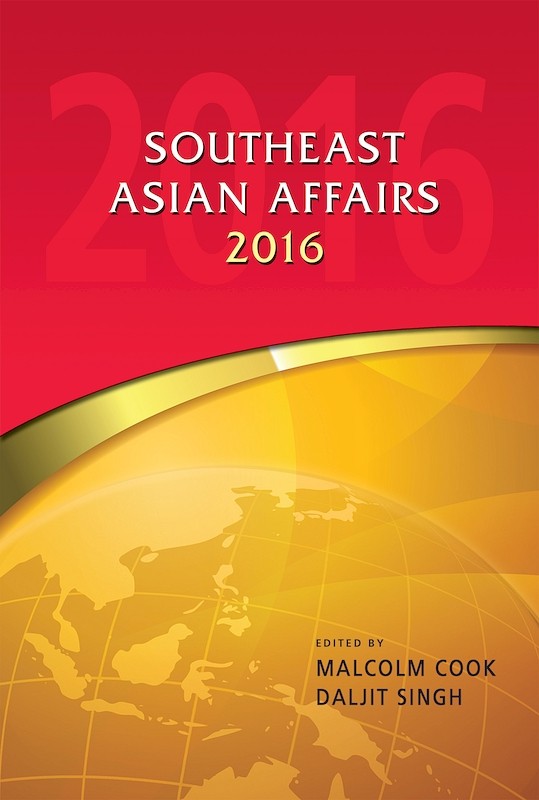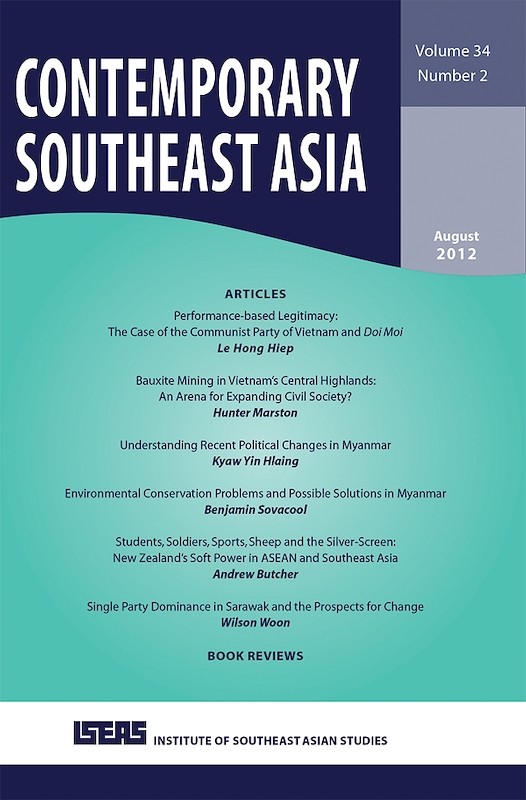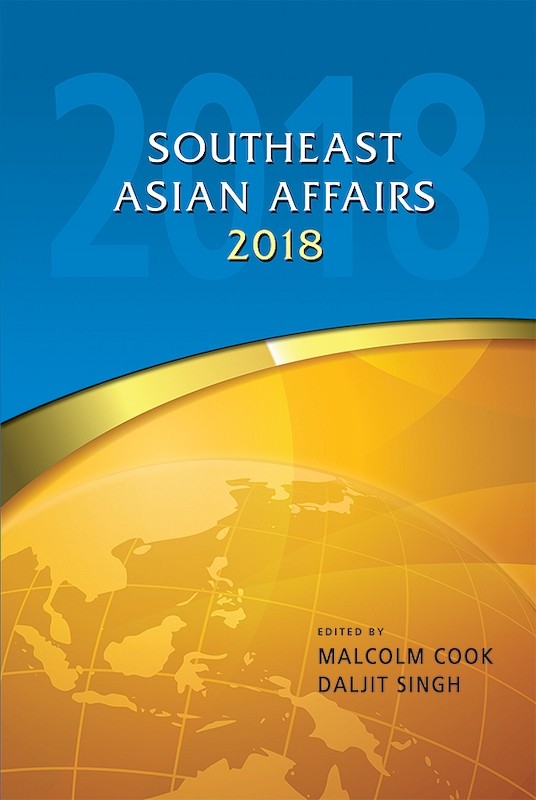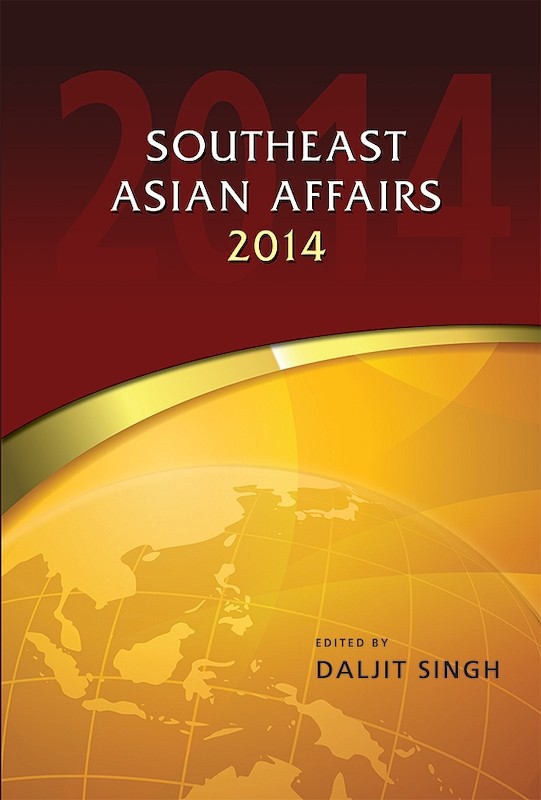Southeast Asian Affairs 2013
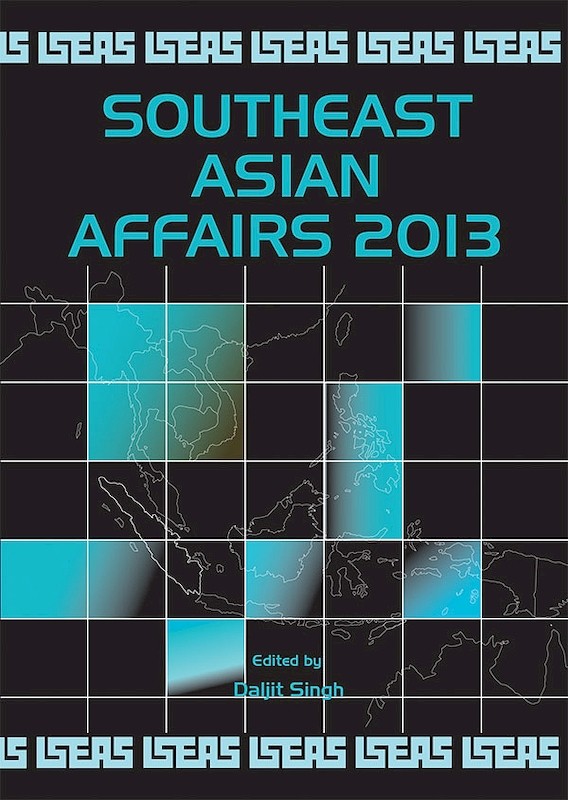
Daljit Singh, editor
Date of publication:
2013
Publisher:
Institute of Southeast Asian Studies
Number of pages:
365
Code:
SEAA13
About the publication
"Southeast Asian Affairs is the only one of its kind: a comprehensive annual review devoted to the international relations, politics, and economies of the region and its nation-states. The collected volumes of Southeast Asian Affairs have become a compendium documenting the dynamic evolution of regional and national developments in Southeast Asia from the end of the ‘second’ Vietnam War to the alarms and struggles of today. Over the years, the editors have drawn on the talents and expertise not only of ISEAS’ own professional research staff and visiting fellows, but have also reached out to tap leading scholars and analysts elsewhere in Southeast and East Asia, Australia and New Zealand, North America, and Europe. A full list of contributors over forty years reads like a kind of who’s who in Southeast Asian Studies.
Regardless of specific events and outcomes in political, economic, and social developments in Southeast Asia’s future, we can expect future editions of Southeast Asian Affairs to continue to provide the expert analysis that has marked the publication since its founding. It has become an important contributor to the knowledge base of contemporary Southeast Asia."
Regardless of specific events and outcomes in political, economic, and social developments in Southeast Asia’s future, we can expect future editions of Southeast Asian Affairs to continue to provide the expert analysis that has marked the publication since its founding. It has become an important contributor to the knowledge base of contemporary Southeast Asia."
Donald E. Weatherbee, Russell Distinguished Professor Emeritus, University of South Carolina
Contents
-
Preliminary pages
-
Southeast Asian Affairs 2013
[Whole Publication, ISBN: 9789814459563] - THE REGION
-
Divided or Together? Southeast Asia in 2012 , by Bridget Welsh, author see abstractThis essay examines the politics and international relations in Southeast Asia in 2012, with the focus on the forces promoting division among and within ASEAN countries. The essay highlights developments in ASEAN itself, with attention to the Cambodia July/November meetings, the introduction of the ASEAN Human Rights Declaration and tensions over economic integration and trade. Reports from public survey data show that Southeast Asians themselves are conflicted over the rise of China, pointing to underlying differences that will be difficult to accommodate in the future. Regional divisions extend to persistent conflicts on the periphery of the region, from Myanmar to Papua in Indonesia, and include widening income inequalities. The year showcases these divisions, but also reinforced commonalities of experience, with increasing attention to people’s needs and a persistent but quiet building of regional architecture. <br>
-
Southeast Asian Economies: Building the Base for Stronger, Better Distributed Growth, by Manu Bhaskaran, author see abstractSome positive forces are emerging in Southeast Asia that will help boost the region's growth prospects and economic resilience. Despite a much more challenging global environment in 2012, the regional economies demonstrated a degree of resilience that few had expected. Economic growth held up, supported by domestic demand. Measures of economic stability performed reasonably well despite some deterioration in the external accounts of a few countries. Economic resilience has been helped by economic reforms which have promoted stronger macro-economic stability, more effective government capacity to boost demand and stronger balance sheets in the financial and corporate sectors. Economic growth prospects appear brighter as more synergies from economic integration flow, once-laggard economies revive and investment ratios rise.
-
Southeast Asia in America’s Rebalance to the Asia-Pacific, by Satu P Limaye, author see abstractSoutheast Asia is critical to success of the US “pivot” to Asia. American efforts are aimed at strengthening bilateral security alliances, deepening working relationships with emerging partners, engaging with regional multilateral institutions, expanding trade and investment, forging a broad-based military presence, and advancing democracy and human rights. Achievements in each of these areas across Southeast Asia will not be smooth or swift. But a structural process of institutionalizing US-Southeast Asia relations is occurring which not simply or only a function or derivative of US-China relations.
-
Chinese Perspectives on the U.S. Role in Southeast Asia, by Zhu Feng, author see abstractThere is a tendency in China to see the “rebalancing” as the latest U.S. effort to contain China. According to Zhu, the rebalancing sharpens the security dilemma between the United States and China, increases strategic distrust, and makes increase of tensions more likely. But rebalancing will not make China soften its position on maritime disputes. Rather than opt for a balance of power, Southeast Asian countries should enhance cooperation with China to settle the South China Sea disputes and show sensitivity to China’s deep sense of insecurity. While acknowledging that the United States has important interests in Southeast Asia and strong bonds with the region, he reminds that Southeast Asia is not a U.S. backyard and China, which now wields a bigger economic clout in Southeast Asia, also has its interests. <br>
- BRUNEI DARUSSALAM
-
Brunei Darussalam in 2012: Towards a Zikir Nation, by Hajah Sainah Haji Saim, author see abstractIn the process of its pursuit of Wawasan (Vision) 2035, it was evident that Brunei Darussalam was preoccupied with an array of issues throughout 2012. Amidst domestic challenges and turbulent global trends, the nation foresees itself, in the future, as a modern, resilient and dynamic nation which also fulfills spiritual obligations while dealing with worldly challenges. There was an increase in a commitment to upholding Islamic obligations and practices.
- CAMBODIA
-
Cambodia in 2012: Towards Developmental Authoritarianism?, by Kheang Un, author see abstractCambodia witnessed the passing of former King Norodom Sihanouk, the declining health of the CPP’s President Chea Sim, and further consolidation of the power of Prime Minister Hun Sen. The Prime Minister presided over Cambodia’s movement into an era of transformation in the spheres of politics, economics and international affairs. These developments, arguably, marked the beginning of a possible new era of developmental authoritarianism. The Prime Minister cannily employed Cambodia’s rising economy, and regional and global linkages to broaden the country’s economic opportunities through foreign investment and building infrastructure. At the same time, the government constricted space for civil and political liberty. <br>
-
Cambodia’s Border Conflict with Thailand, by Pou Sothirak, author see abstractThis chapter examines the border dispute between Cambodia and Thailand against a backdrop of historical animosity and fierce nationalistic tensions between both countries. It outlines the various approaches each country has taken to resolve the dispute. Thailand has indicated its preference for a bilateral approach while Cambodia has directed its efforts towards a multilateral approach, citing a lack of confidence in bilateral negotiations. In late July 2012, both countries withdrew their troops from a provisional demilitarised zone in accordance with an order by the International Court of Justice (ICJ). Thus far, little progress has been achieved by way of resolution. <br>
- INDONESIA
-
Indonesian Politics in 2012: Graft, Intolerance, and Hope of Change in the Late Yudhoyono Period, by Greg Fealy, author see abstractAs Susilo Bambang Yudhoyono enters the second-last year of his final presidential term, Indonesia’s competing political forces are grappling over the succession and the future direction of the nation’s democracy. The government and major parties have succeeded in recent years in rolling back some of the democratic reforms and many observers expected this process to continue. While the year has had its share of “politics as usual” events, particularly relating to corruption scandals, ambivalence towards sectarianism and policy backdowns, it also saw evidence of an emerging desire for change and especially regeneration and reform. The election of Joko Widodo as Jakarta governor was the clearest sign of this trend and opinion surveys suggest the possibility of a similar process in the 2014 presidential elections.
-
Resource Nationalism and Constitutional Jihad, by Ahmad D Habir, author see abstractThe Constitutional Court ruling that disbanded BP Migas could be seen as an indication of resource nationalism in Indonesia or as normal politics on the approach of national elections in 2014. It was also an outcome made possible by the reforms and the democratization process since the end of the New Order. This chapter looks at the dynamics of resource nationalism in the oil and gas industry and the democratization process in the national and global context. The dynamics involve two competing versions of resource nationalism, traditional nationalists as represented by the petitioners pushing for "constitutional jihad" and nationalist modernizers represented by those in the government pushing for Pertamina, the national oil company, to compete internationally. <br>
- LAOS
-
Laos in 2012: In the Name of Democracy, by Holly High, author see abstractPopular dissatisfaction with land issues, corruption and inequitable outcomes from economic development meant that the limits of political criticism and debate continued to be tested in 2012. The National Assembly attempted to position itself as the primary forum for voicing serious complaints about the government. Regional and international relations saw Laos modify domestic laws and ratify international agreements, some of which provided a renewed legal footing for political expression. By year’s end it was evident that there are streams of critical political expression in Laos, that legal frameworks to accommodate it are being slowly strengthened, and that the new spaces these frameworks provide are being hesitantly tested. This has brought sometimes harsh repercussions, as experimental uses of the new spaces for political expression were met with new attempts to limit them.
- MALAYSIA
-
Malaysia in 2012: Promises of Reform; Promises Met?, by Graham K Brown, author see abstractGraham Brown provides an analysis of Prime Minister Najib Tun Razak’s promised legal, political, social, and economic reform. Najib’s short-term survival was dependent upon change but the reverse was true for UMNO. Importantly, many of the legal reforms, for instance, are more symbolic concessions that compromise rather than protect fundamental liberties. However, Brown observes that Najib has a harder time blindsiding Malaysians on electoral transparency, having bowed to pressure over immigrant votes by announcing the creation of a Royal Commission of Inquiry on illegal immigrants in Sabah. Contestations over the use of Allah and over the possible implementation of hudud continued in the socio-political landscape. <br>
-
Shades of Citizenship: Betwixt the Civic and the Ethnic, by Lee Hock Guan, author see abstractIn 1991, the “bangsa Malaysia” vision sparked a heated debate between the ethnic groups over the rights to citizenship status and the status of citizenship rights in Malaysia. The citizenship form in Malaysia remains bounded in the colonial construction of membership. British indirect rule identified the Malay states with a particular ethnicity, bestowed by its indigenous position, and used a mixture of jus sanguinis (right of blood) and jus soli (right of the soil) principles to classify colonial subjects into different classes of membership that have access to differential rights and privileges. After the Japanese Occupation, the British plan to introduce a civic citizenship was jettisoned when the Malays fiercely resisted. Consequently, because UMNO advocated an ethnic citizenship to grant the Malays special rights by virtue of their indigenous position, both civic and ethnic elements of citizenship were contradictorily embedded in the Mederka Constitution.
- MYANMAR
-
Myanmar in 2012: mhyaw ta lin lin or Great Expectations, by Robert H. Taylor, author see abstractAfter years of being held up as one of the outposts of tyranny and the only pariah government in Southeast Asia, by the end of 2012 Myanmar was being toasted as a newly reformed champion of political opening and "democratic" transition, a model for persisting "tyrannies" to emulate. However, old problems remain unresolved and new ones have been created. Little aid or investment has come in new economic sectors with few new jobs. Constitutional governance is proving difficult to manage as the executive, legislative and judicial branches all attempt to define their roles in the new order. Old ethnic conflicts and resource demands are now freely exposed, but this sometimes generates more passion that resolution. The year was one of great, but unfulfilled, expectations. <br>
-
Myanmar’s 2012 By-Elections: The Return of NLD, by Tin Maung Maung Than, author see abstractMyanmar’s by-election held on 1 April 2012 was a landmark event in the process of political transition from military rule to an elected government. It brought back the National League for Democracy (NLD) and its leader Daw Aung San Suu Kyi into the political mainstream and led to the easing of stifling Western sanctions imposed in the name of human rights and democracy. Daw Aung San Suu Kyi who won a seat in the Lower House was subsequently appointed to the chair of the committee dealing with issues on rule of law and tranquility and became an active participant in the political process whose legitimacy she had questioned earlier.
- THE PHILIPPINES
-
The Philippines under Aquino III, Year 2: A Ponderous Slog Continues, by Patricio N Abinales, author see abstractGovernment and private sector excitement over a seven percent growth in the Philippine economy in 2012 must be tempered by the persistence of understated negatives: the decline of foreign direct investments, the unhampered expansion of the illicit economy, and rising poverty levels. The inclusion of forty Filipinos in the Forbes-Asia list of the richest in Asia only highlighted the irony between economic performance and the flagrant discrepancies in incomes. But the political repercussions that could have risen from this economic anomaly never took any serious turn. President Benigno Aquino III’s success in going after his opponents, foremost former President Gloria Arroyo, had kept public’s approval of his work relatively high. The failure of the opposition to congeal into an effective force also reinforced this relative political stability.
-
The Philippines in the South China Sea: Out of Time, Out of Options?, by Maria Ortuoste, author see abstractPhilippine options in the South China Sea are limited by the evolving regional security environment and national political dynamics. Not only does the government have to eliminate corruption, inefficiencies and the politicization of its external security concerns, but it also has to contend with a regional environment marked by a stronger and less cooperative China, a post-Iraq U.S. presence, and faltering multilateralism in ASEAN. Ironically, it is China’s own actions that might have opened another opportunity for the Philippines. <br>
- SINGAPORE
-
Singapore in 2012: A Year of Scandals, Attempted Political Engagement, and Socio-economic Anxieties, by N Ganesan, author see abstractThe year 2012 witnessed a number of interesting political developments that included the Hougang by-election, the resignation of the Speaker of Parliament and the start of a National Dialogue on the country’s future. In economic news, worries persisted over skyrocketing property prices, the cost of living, persistently high inflation and the growing number of foreign workers while sex and corruption scandals stole the show in the social arena. Apart from a small hiccup with Malaysia, foreign affairs held an even course and important bilateral relations were strengthened.
-
Singapore’s Population Conundrum: The Great Balancing Act 2, by Yap Mui Teng, author see abstractIn January 2013, the Singapore government is expected to issue a White Paper on Population which is likely to address the issue of ultra-low fertility, rapid ageing and decline of the population and workforce, and immigration. Over the last decade, the Total Fertility Rate (TFR) has fallen below 1.3 births per woman in spite of policy measures to promote marriage and childbearing. A sudden influx of foreigners to meet labour shortage and the shortfall in births has triggered unprecedented unhappiness among Singaporeans who complained about over-crowding and competition for jobs and other resources. While remedial measures are being undertaken to address the population’s concerns, the longer-term conundrum remains.
- THAILAND
-
Thailand in 2012: A Year of Truth, Reconciliation, and Continued Divide, by Chairat Charoensin-o-larn, author see abstractAfter half a decade of political volatility, 2012 for Thailand could perhaps be best described as another year of uncertainty and instability. Political conflict and southern violence remain the two defining forces for the country. The Yingluck government had begun to face a new round of the anti-Thaksin protest in late October. Violence in the south, which escalated from July, only added to this uncertainty. Indeed, the overall political situation in Thailand in 2012 went beyond the point of accommodation. In the process of hegemonic construction, truth and reconciliation become mere tools in the contest.
- TIMOR-LESTE
-
Timor-Leste in 2012: The Harsh Reality of Independence, by Damien Kingsbury, author see abstractTimor-Leste celebrated its tenth anniversary of independence in 2012, held largely peaceful elections and, so far as it was able at this early stage of its development, consolidated its young democracy. The economy also grew strongly but this was almost entirely a result of government spending based on unsustainable use of the country’s $11 billion petroleum fund. Timor-Leste's human development indicators showed improvement, if off very low levels, but for many Timorese little had changed much over the 10 years the country had been running its own affairs. The uncertainty hanging over Timor-Leste's future was whether after the end of the UN mission and the withdrawal of peacekeepers of stability could be sustained.
- VIETNAM
-
Vietnam in 2012: A Rent-Seeking State on the Verge of a Crisis, by Alexander Vuving, author see abstractOver the last 26 years, Vietnam’s Communist Party-ruled state has evolved into a rent-seeking state whose ethos is to create barriers and extract rents from society rather than to transform society into a one that is imbued with socialist values (the classical communist state) or to facilitate rapid economic growth (the developmental state). The year 2012 marked a dramatic milestone on the road of this rent-seeking state towards a crisis. The chapter chronicles the year’s most important events and spotlights the key dynamics of Vietnam’s economy, politics, and foreign relations. It argues that a key feature of Vietnam’s domestic politics was the clash between group led by VCP General Secretary Nguyen Phu Trong and by Prime Minister Nguyen Tan Dung respectively. It also discusses the major dilemmas facing Vietnam’s, foreign policy.
-
Navigating the Crisis: The VCP’s Efforts to Restructure the Economy and Fight Corruption, by Le Hong Hiep, author see abstractThis chapter analyses recent efforts of the Vietnamese Communist Party (VCP) to promote its performance-based legitimacy against the backdrop of the country’s poor economic performance over the last few years. It contends that restructuring the economy and intensifying the fight against corruption have been adopted by the VCP as two major measures to enhance popular support for the Party. Although both these measures have achieved certain progress, the actual results still leave much to be desired mainly because of the VCP’s unwillingness to embrace radical reforms. Therefore, although the two measures tend to help the VCP gain more popular support in the short run, whether or not they are sufficient to significantly improve Vietnam’s economic and political landscape in the long run still remains to be seen.

![Journal of Southeast Asian Economies Vol. 30/1 (Apr 2013) [formerly ASEAN Economic Bulletin]](/cover/AE30-1.jpg)

